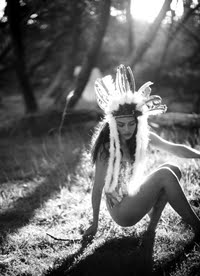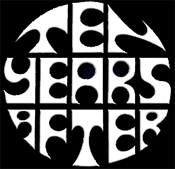
Formed in the summer of 1964, by amateur avant-garde musician George Hunter and music major Richard Olsen, the earliest line up of The Charlatans featured George Hunter (autoharp, vocals), Olsen (bass, vocals), Mike Wilhelm (lead guitar, vocals), Mike Ferguson (piano/keyboards, vocals), and Sam Linde (drums). Linde's drumming was felt to be substandard by the rest of the band and he was soon replaced by Dan Hicks (drums, vocals). The group was known for their style of dress, clothing themselves in late 19th century attire, as if they were Victorian dandies or Wild West gunslingers. This eye-catching choice of clothing was influential on the emerging hippie counter-culture, with young San Franciscans dressing in similarly late Victorian and early Edwardian era clothing.
In June 1965, the Charlatans began an extended residency at the Red Dog Saloon in Virginia City, Nevada, just across the border from Northern California. This six week stint at the Red Dog was important because band members Mike Ferguson and George Hunter produced a rock concert poster in advance of the residency to promote the performances. This poster—known as "The Seed"—is almost certainly the first psychedelic concert poster. By the end of the decade, psychedelic concert poster artwork by artists such as Wes Wilson, Rick Griffin, Stanley Mouse, Alton Kelley, and Victor Moscoso had become a mainstay of San Francisco's music scene. There were, in fact, two "Seed" posters, which look almost identical. They are differentiated by their dates. The first lists the band as playing between June 1 and 15, while the second states "Opening June 21".
Another reason that the Charlatans' extended stay at the Red Dog Saloon was important was that, immediately before their first performance at the club, the band members took LSD. As a result, the Charlatans are sometimes called the first acid rock band, although their sound is not representative of the feedback-drenched, improvisational music that would later come to define acid rock.
The Charlatans returned to San Francisco at the end of summer 1965 and, in September, were given the chance to audition for Autumn Records, a label headed by local DJ, Tom "Big Daddy" Donahue. Autumn didn't sign the band, partly due to conflicts between the group and Donahue over suitable material and partly due to lack of money; the label was on the verge of bankruptcy and was sold to Warner Bros. Records early the following year.
 The failed Autumn Records audition proved to be only a minor setback as The Charlatans signed with Kama Sutra Records in early 1966. As home to the Lovin' Spoonful, one of the earliest folk rock bands to find international success, the group thought the label would be the ideal home for their music. However, after the band had recorded a number of songs for the record label and chosen to issue "Codine" as their debut single, the record company vetoed the release, due to the song's drug connotations Ironically, the tune, penned by folk artist Buffy Sainte-Marie, spoke of the dangers of drugs, rather than promoting their use, but Kama Sutra was adamant and refused to release the song
The failed Autumn Records audition proved to be only a minor setback as The Charlatans signed with Kama Sutra Records in early 1966. As home to the Lovin' Spoonful, one of the earliest folk rock bands to find international success, the group thought the label would be the ideal home for their music. However, after the band had recorded a number of songs for the record label and chosen to issue "Codine" as their debut single, the record company vetoed the release, due to the song's drug connotations Ironically, the tune, penned by folk artist Buffy Sainte-Marie, spoke of the dangers of drugs, rather than promoting their use, but Kama Sutra was adamant and refused to release the songInstead, two other songs from the Kama Sutra sessions, "The Shadow Knows" and "32-20", were released by Kapp Records in 1966 as the band's first single, with some copies being housed in a very rare, promotional-only picture sleeve. Unfortunately, Kapp Records failed to adequately promote the release and the single was a commercial flop. The remaining songs recorded for The Charlatans' debut album during the Kama Sutra sessions remained unreleased until they were officially issued for the first time by Big Beat Records in 1996, on The Amazing Charlatans album.
Mike Ferguson was fired from the Charlatans in 1967 and replaced by Patrick Gogerty. Additionally, Terry Wilson was brought in to take over as drummer after Dan Hicks moved to rhythm guitar, enabling him to sing his compositions as a front man for the group. Hicks eventually left the group in 1968 to form his own band, Dan Hicks and his Hot Licks and Gogerty was subsequently fired from the band.
Tensions between George Hunter and the rest of the band escalated throughout 1968 until Mike Wilhelm, Richard Olsen and Terry Wilson decided to disband the group, reforming soon afterward without inviting Hunter back into the band.The Charlatans recruited new member, Darrell DeVore (piano/keyboards, vocals), and soon secured a recording contract with Philips Records. The band released one album with Philips in 1969, titled simply The Charlatans. Unfortunately, the album was a commercial failure, largely due to the band's sound being somewhat outdated by 1969.





















































































2 comments:
Great song choice (Alabama Bound). Before the Charlatans, Michael Ferguson ran an antique store and wore clothing from earlier eras as sort of a marketing tool. Hunter loved the look and soon adopted it himself, and decided to design a band around the antique look despite the fact that he neither sang nor played an instrument. He learned quickly enough.
I saw the Charlatans many times, and their records don't do them justice. I think the same might be true for most of the early S.F. bands. The bands played for dancers, not for a listening audience.
As always a great choice by Bill.
Bob W.
Bob Thanks so much for your constant feedback and rhetoric for the subject matter. Never got to see this band but still enjoyed their magical presence for the times. Bill
Post a Comment